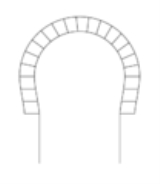
Horseshoe arch
Encyclopedia

Arch
An arch is a structure that spans a space and supports a load. Arches appeared as early as the 2nd millennium BC in Mesopotamian brick architecture and their systematic use started with the Ancient Romans who were the first to apply the technique to a wide range of structures.-Technical aspects:The...
of Islamic architecture. They were formerly constructed in Visigothic Spain
Visigothic art
The Visigoths entered Hispania in 415, and they rose to be the dominant people there until the Moorish invasion of 711 brought their kingdom to an end.This period in Iberian art is dominated by their style...
. Horseshoe arches can take rounded, pointed or lobed form.
Horseshoe arches are known from pre-Islamic Syria
Syria
Syria , officially the Syrian Arab Republic , is a country in Western Asia, bordering Lebanon and the Mediterranean Sea to the West, Turkey to the north, Iraq to the east, Jordan to the south, and Israel to the southwest....
where the form was used in the fourth century CE in the Baptistery of Mar Ya'qub at Nisibin. However, it was in Spain and North Africa that horseshoe arches developed their characteristic form. Prior to the Muslim invasion of Spain, the Visigoths used them as one of their main architectural features. The Visigothic form was adopted and developed by the Ummayyads who accentuated the curvature of the horseshoe and added the alternating colours to accentuate the effect of its shape. This can be seen at a large scale in their major work, the Great Mosque of Córdoba. This style of horsehoe arch then spread all over the Calliphate and adjacent areas, and was adopted by the successor Muslim emirates of the peninsula, the taifa
Taifa
In the history of the Iberian Peninsula, a taifa was an independent Muslim-ruled principality, usually an emirate or petty kingdom, though there was one oligarchy, of which a number formed in the Al-Andalus after the final collapse of the Umayyad Caliphate of Córdoba in 1031.-Rise:The origins of...
s, as well as by the Almoravids
Almoravids
The Almoravids were a Berber dynasty of Morocco, who formed an empire in the 11th-century that stretched over the western Maghreb and Al-Andalus. Their capital was Marrakesh, a city which they founded in 1062 C.E...
, Almohads and the Nasrid Kingdom of Granada, although also lobed, round, pointed and multifoilde arches were also used at that time. The Mozarab
Mozarab
The Mozarabs were Iberian Christians who lived under Arab Islamic rule in Al-Andalus. Their descendants remained unconverted to Islam, but did however adopt elements of Arabic language and culture...
s also adopted this style of arch into their architecture and illuminated manuscripts.
Horseshoe arches were also used in the Mosque of Uqba, in Kairouan
Kairouan
Kairouan , also known as Kirwan or al-Qayrawan , is the capital of the Kairouan Governorate in Tunisia. Referred to as the Islamic Cultural Capital, it is a UNESCO World Heritage site. The city was founded by the Arabs around 670...
and, in a slightly pointed form, in the Mosque of Muhammad ibn Khairun, Tunisia. Mudéjar
Mudéjar
Mudéjar is the name given to individual Moors or Muslims of Al-Andalus who remained in Iberia after the Christian Reconquista but were not converted to Christianity...
style, developed from the 12th to the 17th centuries, continued the tradition of horseshoe arches in the Iberian Peninsula which had been started in the 7th century by the Visigoths.
In addition to their use across the Islamic world, horseshoe arches became popular in Western countries at the time of the Moorish Revival
Moorish Revival
Moorish Revival or Neo-Moorish is one of the exotic revival architectural styles that were adopted by architects of Europe and the Americas in the wake of the Romanticist fascination with all things oriental...
. They were widely used in Moorish revival synagogues.

